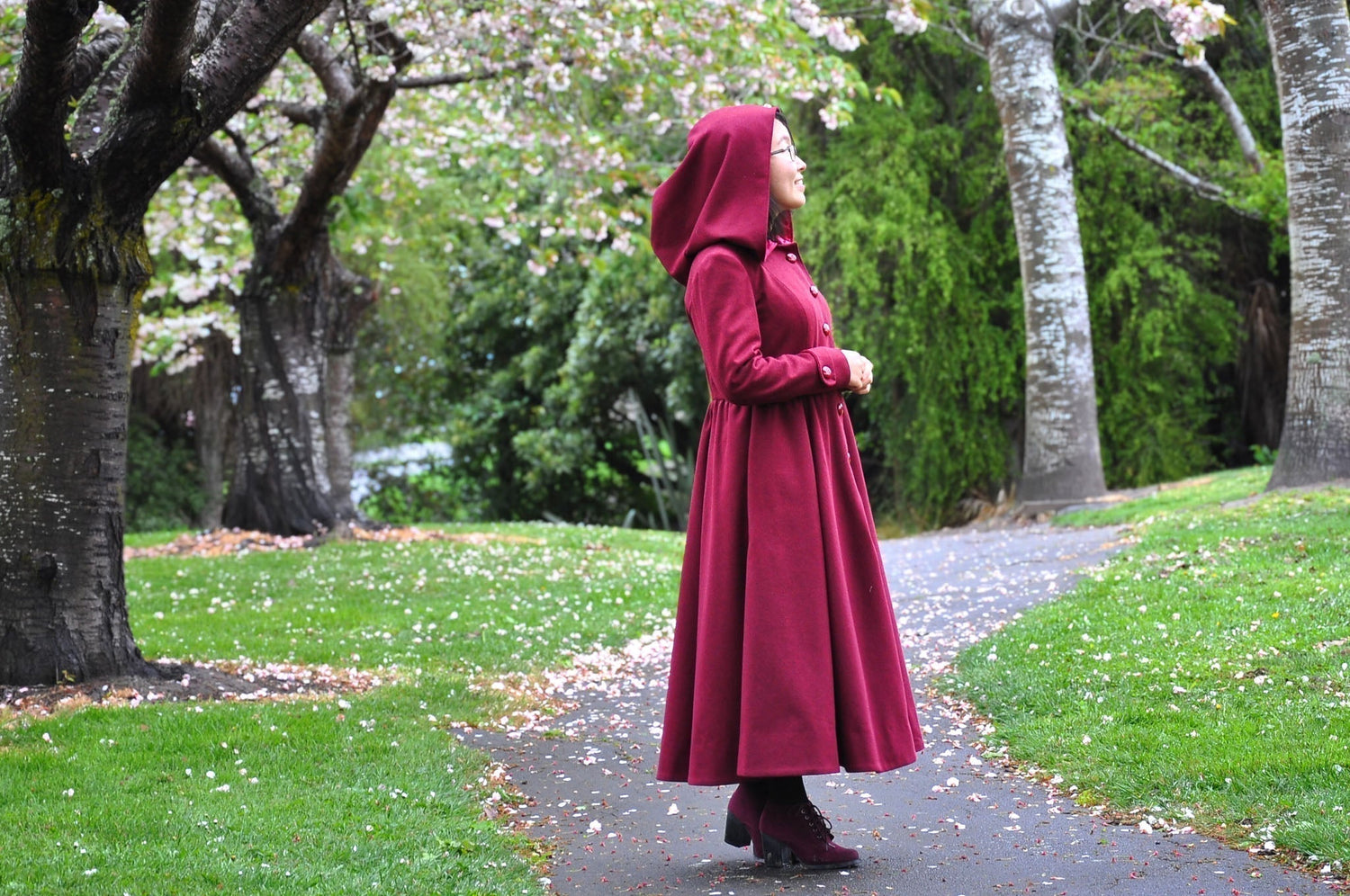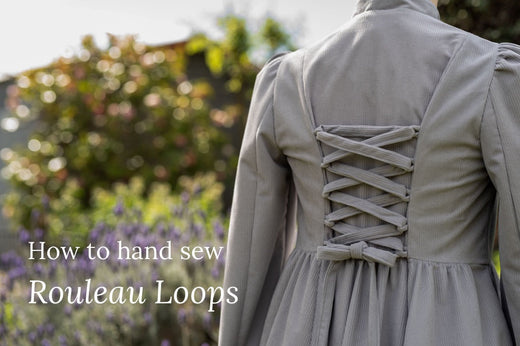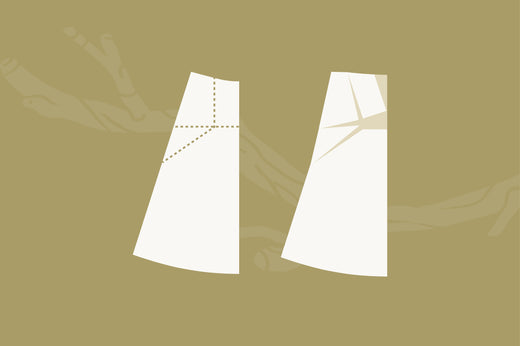The Flourish Dress Coat and Bloom Jacket are special. They aren't quick weekend projects, but rather projects that invite you to settle in and savour the journey, carefully cutting and stitching all those beautiful details and refining the fit until it's just right.
There are materials to consider too. The Flourish Coat in particular requires quite a lot of fabric to achieve that dreamy, full skirt.
So yes, Flourish and Bloom deserve a little planning. Taking time to choose the right fabric is an important part of the process, and really, part of the fun.
Below, we're sharing some things to consider when choosing your fabric, plus examples from our Sew + Show team who made these patterns in a wide variety of different fabrics. Hopefully it helps you feel confident taking the plunge!
The Flourish Dress Coat and Bloom Jacket call for medium weight woven fabrics with some structure and no stretch (you can find the fabric recommendations and yardage requirements in the pattern listings). This includes fabrics like linen, linen-wool blends, wool suiting, soft corduroy or twill, and some thinner types of velvet.
However, during testing, it became apparent that many people would like to make warmer coats too, so we experimented with heavier fabrics like wool coating. The result? Flourish and Bloom both work with a wide range of fabrics, but if you'd like to make them out of something heavier, there are certain considerations to take into account.
Here are some examples so you can see how they look sewn up in different fabric types...
Here's a Bloom Jacket that Amanda made with fabric that's on the lighter-weight end of the spectrum: a sunshiny cotton calico outer and an upcycled sheet for lining. This combo works well for a lightweight layer - perhaps a jacket for warmer spring days or summer evenings. The calico shows off the puffed sleeves, gathered cuffs, and peplum shape beautifully, and the lighter weight of the fabric makes details like the peplum gathering and the rouleau loops easier to handle.
 Aurora sewed her Flourish Coat in a beautiful jewel-toned linen, which really shows off the drape and swish of the skirt. Linen works so well for creating a light to mid-weight coat - it has enough structure to hold the shape of the coat and lovely drape that will make the skirt really shine. Plus, linen just gets better with age - it's a timeless classic and a great choice for heirloom garments.
Aurora sewed her Flourish Coat in a beautiful jewel-toned linen, which really shows off the drape and swish of the skirt. Linen works so well for creating a light to mid-weight coat - it has enough structure to hold the shape of the coat and lovely drape that will make the skirt really shine. Plus, linen just gets better with age - it's a timeless classic and a great choice for heirloom garments.
 Here's a Bloom Jacket made from Portugese cotton flannel, another mid-weight option. The fabric isn't too heavy, so Megan was able to make her ties and rouleau loops from the exterior fabric, which gives a cohesive look. This is a lovely, soft option for a spring or autumn jacket, and the herringbone weave of the flannel is such a classic look.
Here's a Bloom Jacket made from Portugese cotton flannel, another mid-weight option. The fabric isn't too heavy, so Megan was able to make her ties and rouleau loops from the exterior fabric, which gives a cohesive look. This is a lovely, soft option for a spring or autumn jacket, and the herringbone weave of the flannel is such a classic look. Here's a heavier-weight version of the Flourish Coat, made by Carol in a beautiful herringbone tweed wool in a light coating weight. This fabric is roughly 250gsm, and Carol recommends using fabric that is under 300gsm due to the overall weight of the coat. This fabric has the right amount of structure to hold the beautiful details of the coat, like the princess seams and waist gathers, but enough drape to create elegant movement in the skirt. This coat is fully lined in a lightweight, slippery lining fabric, using the Full Skirt Lining Add-On. This is a great choice for a heavier weight coat - it minimises the overall weight of the coat, helps prevent a heavy, "clingy" feeling, and ensures that the skirt can move freely.
Here's a heavier-weight version of the Flourish Coat, made by Carol in a beautiful herringbone tweed wool in a light coating weight. This fabric is roughly 250gsm, and Carol recommends using fabric that is under 300gsm due to the overall weight of the coat. This fabric has the right amount of structure to hold the beautiful details of the coat, like the princess seams and waist gathers, but enough drape to create elegant movement in the skirt. This coat is fully lined in a lightweight, slippery lining fabric, using the Full Skirt Lining Add-On. This is a great choice for a heavier weight coat - it minimises the overall weight of the coat, helps prevent a heavy, "clingy" feeling, and ensures that the skirt can move freely.  Eva sewed her Bloom Jacket out of a heavier velvet that she described as more of a home decor fabric. While it can be difficult to sew with fabrics that have more body and stiffness (for example gathering the sleeves and peplum) the result is a more structured garment that gives quite a different look. We love how the curves of the peplum skirt look almost sculptural.
Eva sewed her Bloom Jacket out of a heavier velvet that she described as more of a home decor fabric. While it can be difficult to sew with fabrics that have more body and stiffness (for example gathering the sleeves and peplum) the result is a more structured garment that gives quite a different look. We love how the curves of the peplum skirt look almost sculptural.
Catherine made this striking red coat in a coating weight wool blend (80% wool, 20% rayon), with a full lining in a slippery rayon fabric. To reduce bulk and weight, she opted to use a lighter fabric for the facings - this makes those thick seams easier to sew (especially where multiple seams join), and makes the coat less bulky to wear. We think the contrast facings make a beautiful, unique feature.
As you can see from these examples, fabric choice can really change the look and functionality of the Flourish Dress Coat and Bloom Jacket. There's a range of fabric that can work well and with certain considerations, you can create outerwear that is customised to your preferences.
If you're interested in making a coat or jacket out of a heavier fabric, there is an entire page of the tutorial dedicated to tips for getting the best possible result.
As ever, we recommend sewing a toile (muslin) before cutting into your good fabric. Take some time to refine the fit of the bodice, shoulders, and sleeves. Investing a bit of extra time will result in a jacket or coat with a beautiful, customised fit.
Read more posts with sewing and fitting techniques for the Flourish Dress Coat and Bloom Jacket here:
- How to sew a ladder stitch and blind hem stitch by hand
- How to hand sew rouleau loops
- How to sew around curves
- How to do an FBA or SBA for a Princess Seam
~ Lovely images by Amanda Bickham, Aurora Lendzian, Megan Hollomon, Carol Kite, Eva Mizer, Catherine Lu ~






